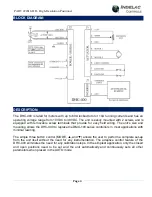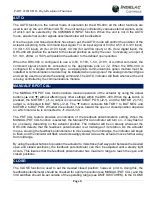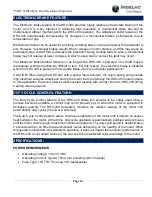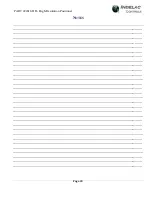
PART #22018-DH - High-Resolution Positioner
Page 8
AUTO:
The AUTO function is the normal mode of operation for the DHC-400; all the other functions are
used to set up the unit. While in AUTO, the unit can be controlled by various external signals, some
of which can be selected by the COMMAND INPUT function. When the unit is not in the AUTO
mode, all external control signals described below will be disabled.
Once the open and closed positions have been set, the AUTO mode will control the position of the
actuator according to the command input signal. For an input signal of 0V (for 0-5V or 0-10V input),
1V (for 1-5V input), 2V (for 2-10V input), 4.0 mA (for 4-20mA input), or 0% (for a digital input), the
DHC-400 will position the actuator to the closed position as set by the user. Conversely, an input of
5V, 10V, 20mA, or 100% will position the actuator to the defined open position.
When the DHC-400 is configured to use a 0-5V, 0-10V, 1-5V, 2-10V, or 4-20mA command, the
command signal should be connected to the appropriate pins on J2. When the DHC-400 is
configured for a Digital command type, an appropriate communications option module must be
installed. A communications module may be installed when using one of the analog command types
and can be used to override the analog command. The AUTO indicator will flash whenever the unit
is being controlled by the communications module.
MANUAL/FB POT CAL:
The MANUAL/FB POT CAL function allows manual operation of the actuator by using the adjust
buttons
(▲ and ▼) without affecting any other settings within the DHC-400. When the ▲ button is
pressed, the MOTOR 1 (J1-4) output is connected to BAT POS (J2-1), and the MOTOR 2 (J1-5)
output is connected to BAT NEG (J2-
2). The ▼ button connects MOTOR 1 to BAT NEG and
MOTOR 2 to BAT POS. Whether the actuator moves toward the open or closed position depends
on which motor wire is connected to J1-4 and J1-5.
The POT CAL feature provides an indication of the feedback potentiometer's setting. When the
MANUAL/POT CAL function is selected, the Manual/Pot Cal indicator will turn on - it may flash or
be on steady, depending on the actuator position. The indicator will be on steady whenever the
DHC-400 detects that the feedback potentiometer is at midrange of its rotation. As the actuator
moves, causing the feedback potentiometer to move away from midrange, the indicator will begin
to flash, and the indicator will flash at a decreasingly slower rate as the actuator moves further away
from midrange.
By using the adjust buttons to position the actuator to mid-stroke (half way point between the desired
open and closed positions), the feedback potentiometer can then be adjusted until a steady light
occurs. This insures that the feedback potentiometer has maximum range to reach the open and
closed positions.
CLOSE:
The CLOSE function is used to set the desired closed position; however, prior to doing this, the
feedback potentiometer should be checked for optimum position (see MANUAL/POT CAL), and the
limit switches should be set outside of the operating range (see LIMIT SWITCHES). In the CLOSE
Summary of Contents for 22018-DH
Page 1: ......
Page 3: ...PART 22018 DH High Resolution Positioner Page 3 BOARD OUTLINE...
Page 17: ...PART 22018 DH High Resolution Positioner Page 17 WIRING DIAGRAMS Output Configurations...
Page 18: ...PART 22018 DH High Resolution Positioner Page 18 WIRING DIAGRAMS Input Configurations...
Page 19: ...PART 22018 DH High Resolution Positioner Page 19 WIRING DIAGRAMS Special Applications...
Page 20: ...PART 22018 DH High Resolution Positioner Page 20 WIRING DIAGRAMS Special Applications...





























